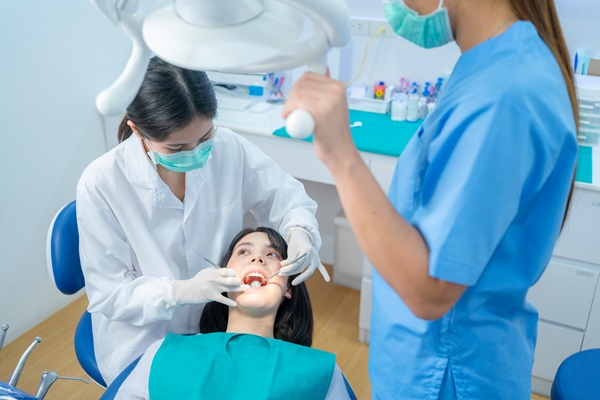CBCT Cone BeamLone Tree, CO
Dental cone beam computed tomography, CBCT cone beam, is a new type of X-ray equipment that uses a 3D cone beam and dental scans to provide dentists with a detailed, three-dimensional image of the mouth. Furthermore, patients do not have to suffer any pain or discomfort during the procedure. A CBCT cone beam can bring about detailed photos of the bones, nerve pathways, soft tissues, and teeth with just a single scan.
CBCT cone beam is available at Creekside Endodontics - Lone Tree Endodontist in Lone Tree and the surrounding area. This advance in dental technology may help save your teeth. Call us today at 303-524-9343 to schedule an appointment or learn more about our services.
Understanding CBCT Cone Beam
CBCT cone beam is a special type of X-ray machine utilized when regular dental or facial X-rays are insufficient. CBCT cone beams can generate 3D images of dental structures, soft tissues, nerve paths, and bone in the craniofacial region in a single scan using a special kind of technology. As such, CBCT cone beam images allow the dentist to plan for more precise treatment.
While CBCT cone beam is not the same as conventional CT, it can still be used to produce images similar to the ones made by traditional CT imaging. With a CBCT cone beam, an X-ray beam in the shape of a cone moves around the patient to produce multiple images, also known as views. Both CT scans and CBCT cone beam produce high-quality images, though CBCT cone beam utilizes a much smaller machine.
Check out what others are saying about our Endodontic services on Yelp: CBCT Cone Beam Lone Tree
How CBCT Cone Beam Works
CBCT cone beam scanners are square-shaped machines, including an upright chair for patients to sit or a moveable table for patients to lie down during the examination. Scanners with a chair have a rotating C-arm, a device that intensifies X-ray images and contains an X-ray source and detector. Scanners with a table include a rotating gantry.
The C-arm or gantry will rotate around the head in a single 360-degree rotation, capturing multiple images from different angles during the examination. These images will then be reconstructed to create a single 3D image. The X-ray source and detector will be mounted on opposing sides of the revolving C-arm or gantry. They will rotate in unison, generating anywhere from 150 to 200 high-resolution 2D images. These are then digitally combined to form a 3D image, providing the dentist with valuable information about the patient's oral and craniofacial health.
CBCT Cone Beam Results
CBCT cone beam scanners bring forth far more detailed images than traditional CT scanners. Consequently, as previously established, they are particularly useful when traditional X-rays are insufficient to bring about the needed treatment information. For example, CBCT cone beams can evaluate the bony structures of the face, dentition, diseases of the jaw, nasal cavity, and sinuses.
CBCT cone beam technology can also be useful in diagnosing oral cancers and cysts and managing impacted teeth. According to one study, CBCT cone beam technology was found to have contributed significantly to the planning and successful surgical management of dentigerous cysts and associated impacted teeth. In addition, as cone beams take wide-range photos, they can capture in-depth areas that traditional scanners may miss.
After the CBCT Cone Beam Procedure
Once the CBCT cone beam procedure has been completed, the dentist will have a clear, 3D image of the teeth, mouth, jaw, neck, ears, nose, and throat. It is possible to review this image immediately and get the best possible view of any area with features such as zooming and rotation. In addition, this is a painless procedure with no recovery time, and the patient will be able to return to their everyday activities immediately.
The dentist will also write a report of the scan results, and the patient will be able to see their images. Finally, the dentist and patient will go over the treatment plan together, during which time the patient can discuss their preferences for the treatment process and aftercare.
Call Us Today
CBCT cone beam can provide us with the necessary information to personalize the best treatment plan for you. We at Creekside Endodontics - Lone Tree Endodontist in Lone Tree can help. Call us today at 303-524-9343 to schedule an appointment or learn more about our services.
Frequently Asked Questions
Will my insurance cover CBCT cone beam scans?
Some insurance companies may cover CBCT cone beam scans. However, this is not a guarantee, as all plans are different. Your best bet is to contact your insurance provider directly. We can help you figure out what is covered in your plan.
What kind of image is produced by a CBCT cone beam scan?
CBCT cone beam scanners take detailed images of the entire head. As teeth positioning affects the entire head, these images allow us to see the underlying bone structure and jawline. With this information, we can create the most accurate treatments possible. CBCT cone beam scanners are particularly beneficial for procedures around delicate areas. They are also useful for planning correctional procedures.
How long does a CBCT cone beam scan take?
These scans are typically quite brief. For example, a CBCT cone beam scan only needs a singular rotation around the head. Once you are positioned, the scan itself will usually be over in less than 30 seconds.
How long have dentists been using CBCT cone beam technology?
According to the Food and Drug Administration (FDA), dentists have been using CBCT cone beam technology for over twenty years. Furthermore, dental scans are becoming increasingly common, thanks to their helpfulness in procedure planning and diagnosing complex conditions.
How much radiation does a CBCT cone beam scan emit?
Though CBCT cone beam scans are still considered computed tomography (CT) scans, they emit considerably less radiation than conventional CT scans. However, it does emit more radiation than a traditional X-ray. Therefore, we will only recommend a CBCT cone beam scan if we judge the benefits greater than the risks.
How should I prepare for a CBCT cone beam scan?
There is little preparation necessary for a CBCT cone beam scan. Make sure to remove all loose or metallic objects before the exam. Stay still and do not swallow or talk during the scan.
Contact Us
Creekside Endodontics - Lone Tree Endodontist is located at 10450 Park Meadows Dr. Suite #306 Lone Tree, CO 80124.
Helpful Related Links
- American Dental Association (ADA). Glossary of Dental Terms. 2021
About our business, license, and website security
- CreeksideEndodontics – Lone Tree Endodontist was established in 2011.
- We accept the following payment methods: American Express, Cash, Check, Discover, MasterCard, and Visa
- We serve patients from the following counties: Douglas County
- We serve patients from the following cities: Lone Tree, Centennial, Highlands Ranch, Parker, Aurora, Denver, Castle Rock and Castle Pines
- National Provider Identifier Database (1710963343). View NPI Registry Information
- Norton Safe Web. View Details
- Trend Micro Site Safety Center. View Details





